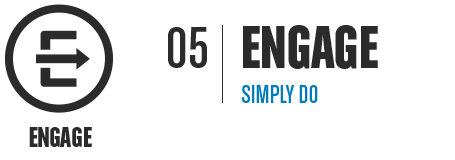 The five steps of GTD workflow are Capture, Clarify, Organize, Reflect, and Engage. When it’s time to Engage, people often ask how to choose from what may be long lists of tasks to do. That’s when it’s helpful to use the criteria for choosing:
The five steps of GTD workflow are Capture, Clarify, Organize, Reflect, and Engage. When it’s time to Engage, people often ask how to choose from what may be long lists of tasks to do. That’s when it’s helpful to use the criteria for choosing:
Context – What place, tool, or person will the action require? This is the first limitation for choosing–it has to be. If you’re not in the right place, don’t have the right tool, or access to the required person, you can’t take the action.
Time available – How much time do you have to take the action? If you have 20 minutes, only consider actions that you think will take less than 20 minutes.
Resources – What is your energy like to take the action? Have you been in back-to-back meetings all day and you’re tired? Or are you just finishing your morning coffee and feeling alert and enthusiastic? You’re probably already considering this more than you realize when you choose what to do.
Priorities – What’s the most important one to choose based on your roles, goals, long-term strategy, and purpose?
How do you know what your priorities are? This is where GTD’s Horizons of Focus® model comes in. GTD defines “work” from six different horizons, corresponding to different altitudes of perspective.
HORIZON 5: Purpose and Principles
HORIZON 4: Vision
HORIZON 3: Goals and Objectives
HORIZON 2: Areas of Focus and Accountability
HORIZON 1: Projects
GROUND: Calendar/Actions
Your priorities are determined from the top down—i.e. your purpose and values will drive your vision of the purpose being fulfilled, which will create goals and objectives, which will frame areas of focus and accountability. All of those will generate projects which will require actions to get them done. Every level of that is valuable, but the Areas of Focus level in particular can be helpful for setting priorities. Know what your job really is and saying “no” will come a little easier.
Finally, look at how you’re spending your time when you Engage. This is where the Three-fold Nature of Work model comes in. It’s a useful way to look at how you spend your time:
Doing pre-defined work – Choosing from work you already clarified and put on your calendar & Next Actions lists
Doing work as it appears – New things that show up that you choose to work on
Defining work – Processing new inputs (swing back to Capture, Clarify, and Organize)
Of those three, where do you spend more time than you think you should? And which one doesn’t get enough of your time?
